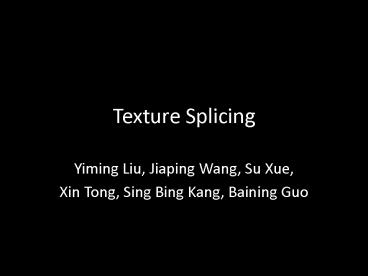Texture Splicing - PowerPoint PPT Presentation
1 / 34
Title:
Texture Splicing
Description:
... Splicing. Yiming Liu, Jiaping Wang, Su Xue, Xin Tong, Sing Bing Kang, ... Graph-cut based segmentation; Image deformation with rigid constraint. Summary (Cont'd) ... – PowerPoint PPT presentation
Number of Views:59
Avg rating:3.0/5.0
Title: Texture Splicing
1
Texture Splicing
- Yiming Liu, Jiaping Wang, Su Xue,
- Xin Tong, Sing Bing Kang, Baining Guo
2
Related Works Texture Synthesis
Similar basic element
Similar placement distribution
3
Related Works Texture Transfer
- Efros and Freeman 2001, Hertzmann et al. 2001
4
Related Works Texture Design
- Matusik et al. 2005 and other works
5
Related Works Texture Element Extraction
- Near-Regular Texture Analysis
- Liu et al. 2004, Hays et al. 06
- Limited to near-regular textures.
6
Texture Splicing
basic element
placement distribution
new texture
7
Texture Analysis (1)
self-similarity search
8
Self-Similarity Search
Texture Image
Normalized Cross Correlation Value
9
Placement Distribution Extraction
Texture Image
Normalized Cross Correlation Value
Placement Distribution
10
(No Transcript)
11
Texture Analysis (2)
Graph Cut
12
Graph Cut based Segmentation
Minimize
13
Different Types of Textures
14
New Texture Generation
Texture A
Distribution A
Texture B
15
Mapping The Points in Source and Target
Distribution
- Get a mapping function fAB
- CAB measures the spatial distance between two
points. - Solved with minimum-cost bipartite graph
matching.
16
Getting Deformation Field W
- Find a deformation field WAB which
- Map texture element p(x, y) in source
distribution to its correspondent position in
target distribution (fx(p), fy(p)) - Preserve the rigidity in the rigid area as much
as possible.
Rigid area
Non-rigid area
17
Getting Deformation Field W
- Solve ?(p) WAB(p) p
- Separate x and y ?(p) (?x(p), ?y(p))
- Energy Function
18
Non-Rigid vs. Rigid (1)
Non-Rigid
Rigid
Texture
Texton Mask
19
Non-Rigid vs. Rigid (2)
Non-Rigid
Rigid
Texture
20
Non-Rigid vs. Rigid (3)
Non-Rigid
Rigid
Texture
21
Barycentric Interpolation
source
output
22
Final Refinement
- Texture Synthesis Lefebvre and Hoppe 2006
- Add fine details to the texture.
- Fix the incorrectly deformed area in the texture.
Before texture synthesis
After texture synthesis
23
(No Transcript)
24
Splicing Result (1)
25
Splicing Result (2)
26
Splicing Result (3)
27
Self Splicing Scaling
28
Self Splicing Randomization
29
Self Splicing Regularization
30
Self Splicing Specific Rearrangement
31
(No Transcript)
32
Summary
- Texture Splicing a novel method for texture
editing. - Simple idea generate new textures with one
textures element and anothers spatial placement
distribution - Self-similarity search
- Graph-cut based segmentation
- Image deformation with rigid constraint.
33
Summary (Contd)
- Simple but useful for users
- The user just need to provide two texture images.
- The user can also directly editing the spatial
placement. - Require more interaction, but
- Provides more control on texture design.
34
Thank You!
- Any questions?































